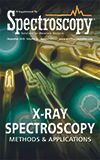Total-Reflection X-Ray Fluorescence Analysis (TXRF)as a Powerful and Cost Competitive Technique for Surface Chemical and Trace Element Analyses
Special Issues
Total-reflection X-Ray fluorescence analysis (TXRF) and grazing-incidence XRF (GIXRF) may be applied for surface and bulk trace element analysis of thin-layered systems. Burkhard Beckhoff of the Physikalisch-Technische Bundesanstalt (PTB) in Germany spoke to us about his recent work in this field.
Over the past decade, total-reflection X-Ray fluorescence analysis (TXRF) has become a valuable analytical technique for surface analysis and bulk trace element analysis. The composition of thin layered systems of low surface and interface roughness can be measured using an X-ray standing wave (XSW) field by tuning the angle of incidence across the critical angle of total external reflection. This technique has been referred to as the grazing-incidence XRF technique (GIXRF). TXRF and GIXRF have been employed for many applications in nanotechnology, and even biotechnology. Using these techniques, information may be obtained for elemental mass depositions and related chemical binding states, which can be revealed when using tunable excitation radiation. We were recently able to interview Burkhard Beckhoff of the Physikalisch-Technische Bundesanstalt (PTB), in Berlin, Germany regarding his recent work in this field.
Jerome Workman, Jr.
You have said that TXRF, and specifically GIXRF, is a powerful technique for surface analysis. Would you describe in detail what specifically GIXRF is, and how it is useful for surface analysis? .
GIXRF analysis is X-ray fluorescence analysis under varying grazing incidence (GI) conditions of the incident X-ray beam with respect to the sample surface. The variation of the angle of incidence results in different excitation conditions allowing for depth profiling in a controlled manner. In case of very flat samples, the nano-scaled depth modulation of the excitation conditions is given by the strength of the X-ray standing wave (XSW) field, which depends on the spatial distribution of the elements to be analyzed. In the case of rough samples, line intensity ratios of matrix elements can be used for depth profiling at the micro-scale. Compared to TXRF, that is XRF under total-reflection conditions, the angles of incidence can be about six times larger. However, the detection sensitivity of GIXRF is about one to two orders of magnitude smaller at the surface as compared to TXRF analysis.
Would you explain for our readers what TXRF chemical traceability is, based on calibration using one- or multielemental solutions? How is this calibration procedure conducted and what are its limitations?
In general, chemical traceability in TXRF is established by means of a well known amount of substance of an element, which is added to the sample of interest as a standard. For example, gallium (Ga) can be used as an internal standard for conventional TXRF. The reliability of the TXRF quantification based on an internal standard strongly depends on having a very similar spatial distribution of this standard as compared to the element(s) analyzed. In addition, the linear response of TXRF is only valid below a certain value of the total mass deposition of the sample, being in the nanogram range. Otherwise, ideal TXRF analytical conditions are not valid, as can be easily revealed by an angular scan in GIXRF mode.
The GIXRF technique has been described in the literature (1), and multiple applications of TXRF and GIXRF have been demonstrated in bio- and nanotechnologies (2–7). What are some of the most important applications of GIXRF or general TXRF from those you have described?
In view of TXRF’s high detection sensitivity ranging between femtogram (fg) and picogram (pg) for absolute masses, or expressed as mass depositions in the 109 atoms/cm2 to 1011 atoms/cm2, typical applications range from drinking water analysis and wafer surface contamination control, which are well in line with the linear TXRF quantification regime; to the geological, biological, pharmaceutical, industrial, archaeometric, and forensic fields, where the elemental mass depositions may be higher.
Ideal applications of GIXRF range from biomedical and environmental sciences (such as size-fractionated aerosols deposited on substrates), over nano- and microlayered advanced materials (such as solid state batteries and photovoltaics) to nanoscaled 3D patterns such as test structures in nanoelectronics.
What are some of the key details of the data analysis tools that have been developed to analyze TXRF and GIXRF data? For example, your modeling approach of reference-free GIXRF-XRR data (7)?
For surface contamination or nanolayer analysis, both these methods require reliable knowledge on the depth dependent intensity of the X-ray standing wave (XSW) field arising when the incident and reï¬ected beams interfere with each other. There are public domain XSW software and related library data of optical constants or complex refraction indexes. Moving on from 2D nanolayers to 3D nanostructures GIXRF has the potential to reveal analytical information on depth profiles or cap layers of 3D structures while the method of XRR provides complementary dimensional information. The transition from 2D to 3D objects requires the solution of 3D Maxwell equations by means of appropriate solvers, going well beyond the conventional matrix XSW algorithms used in TXRF and GIXRF.
Would you briefly describe your work and its importance as related to liquid-metal jet X-ray sources (8)? What is the significance of this work, and what are the technical challenges?
Liquid-metal jet X-ray sources are among the most promising concepts for high-brilliance and high-flux sources for XRF laboratory applications. High power induced radiation damage of the anode is avoided by the continuous provision of new liquid material. Due to the lack of certified reference materials at the nanoscale (see http://www.nano-refmat.bam.de/en/), the alternate route to employ calibrated instrumentation is getting more relevant. For this purpose, we determined the absolute emission intensity of a liquid-metal jet for the first time. The technical challenges involve the stability of such sources and their application for combined in-situ XRD and GIXRF investigations of chalcopyrite photovoltaics.
What measurement improvements in physical or chemical measurements, speed of analysis, detection limit, or sample handling have you been able to achieve in your research? .
Apart from having arranged for instrumentation allowing for sample sizes from 5 mm up to 300 mm wafers, we arranged for calibrated wavelength-dispersive spectrometers in the soft and hard X-ray ranges. These spectrometers enable novel concepts to determine atomic fundamental parameters, such as fluorescence yields and ionization cross sections needed for improved traceability in X-ray spectrometry. Currently, we are building an even more efficient soft X-ray spectrometer arrangement, allowing for the simultaneous recording of X-ray emission in two orthogonal polarization directions. This instrument is expected to be used by both the German and US metrology institutes for high-resolution X-ray emission spectroscopy.
What do you anticipate is your next area of research in this field; what would be your next steps to advance this work?
I expect three different developments gaining speed in applied X-ray spectrometry. The correlation of materials functionality with the underlying chemical and physical properties is calling for steadily improved in-situ and operando metrology. This involves the characterization of next generation batteries and photovoltaics. Second, the inspection of nanostructures will require combined analytical and dimensional information. Here, grazing emission XRF will complement GIXRF schemes, in particular for laboratory applications. Third, quality management procedures used in industrial manufacturing and R&D call for improved ISO regulation. The German mirror committee to ISO TC201 (surface chemical analysis) is expecting to receive proposals for improved TXRF regulation, and later on, for GIXRF applications.
References
(1) R. Unterumsberger, B. Pollakowski, M. Müller, and B. Beckhoff, Anal. Chem. 83(22), 8623–8628 (2011).
(2) B. Pollakowski-Herrmann, A. Hornemann, A.M. Giovannozzi, F. Green, P. Gunning, C. Portesi, A. Rossi, C. Seim, R. Steven, B. Tyler, and B. Beckhoff, J. Pharm. Biomed. Anal. 150, 308–317 (2018).
(3) A.M. Giovannozzi, A. Hornemann, B. Pollakowski-Herrmann, F.M. Green, P. Gunning, T.L. Salter, R.T. Steven, J. Bunch, C. Portesi, B.J. Tyler, and B. Beckhoff, Anal. Bioanal. Chem. 411(1), 217–229 (2019).
(4) P.M. Dietrich, C. Streeck, S. Glamsch, C. Ehlert, A. Lippitz, A. Nutsch, N. Kulak, B. Beckhoff, and W.E.S. Unger, Anal. Chem. 87(19), 10117–10124 (2015).
(5) T. Fischer, P.M. Dietrich, C. Streeck, S. Ray, A. Nutsch, A. Shard, B. Beckhoff, W.E. Unger, and K. Rurack, Anal. Chem. 87(5), 2685–2692 (2015).
(6) F. Reinhardt, S.H. Nowak, B. Beckhoff, J.C. Dousse, and M. Schoengen, J. Anal. At. Spectrom.29(10), 1778–1784 (2014).
(7) V. Soltwisch, P. Hönicke, Y. Kayser, J. Eilbracht, J. Probst, F. Scholze, and B. Beckhoff, Nanoscale10(13), 6177–6185 (2018).
(8) M. Wansleben, C. Zech, C. Streeck, J. Weser, C. Genzel, B. Beckhoff, and R. Mainz, J. Anal. At. Spectrom. 34, 1497–1502 (2019).

Burkhard Beckhoff is affiliated with X-ray spectroscopy at the German National Metrology institute Physikalisch-Technische Bundesanstalt (PTB), where he is currently working as a researcher and head of PTB’s X-Ray Spectrometry group. Beckhoff has authored and co-authored several national and international publications and also working as a reviewer for reputed professional technical journals. Beckhoff has an active role with different scientific societies and academies around the world. He has received several awards for contributions to analytical science. His major research interests involve quantitative X-ray spectroscopic measurement techniques using synchrotron radiation for their development towards laboratory applications. He is coordinator of the European research project AEROMET on aerosol metrology and organizer of the European E-MRS symposia ALTECH on nanomaterials characterization.

AI Shakes Up Spectroscopy as New Tools Reveal the Secret Life of Molecules
April 14th 2025A leading-edge review led by researchers at Oak Ridge National Laboratory and MIT explores how artificial intelligence is revolutionizing the study of molecular vibrations and phonon dynamics. From infrared and Raman spectroscopy to neutron and X-ray scattering, AI is transforming how scientists interpret vibrational spectra and predict material behaviors.
Advancing Corrosion Resistance in Additively Manufactured Titanium Alloys Through Heat Treatment
April 7th 2025Researchers have demonstrated that heat treatment significantly enhances the corrosion resistance of additively manufactured TC4 titanium alloy by transforming its microstructure, offering valuable insights for aerospace applications.